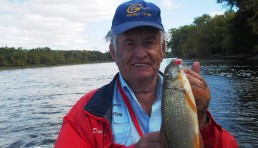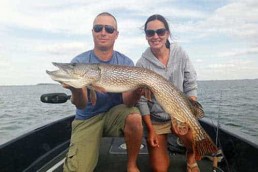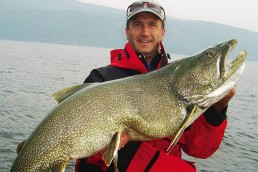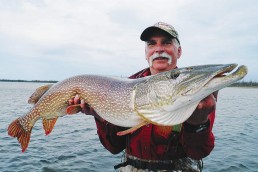Ontario’s Trophy Walleye Secret
Today, the Attawapiskat River still remains a secret—just as it was 36 years ago. No outfitter has exploited its treasures. Leuenberger Flying Service out of Nakina, Ont. introduced me to the river on a five-day fly-in trip. Leuenberger had built a temporary two-room cabin on one of the river’s backwaters two blocks off the main river. These waters provided enough landing room for a Beaver float plane to bring in anglers.
This location is an experimental outpost.
Along with myself was my dear friend Dave Conn, our company’s legal consultant, Ken Schultz, fishing editor of Field and Stream and Bob Greg. Two native guides would travel downriver the 80 miles from the native village of Landsdowne House to meet us and act as guides. My report to Ernie Leuenberger Sr. would be the catalyst, which would then determine if the camp was a go or a no-go.
To locate the exact location, one must look for a large location, Pym Island, on a topo map. Here, the river divides into two streams and rejoins 10 miles downstream. The Attawapiskat is a slow, wide, sluggish river that hosts lily pad and reed structures along its shoreline for northern pike and walleyes.
On our arrival, two members of the Martin family greeted us and helped unload our gear. Then, they readied the 18-foot, square stern canoes for fishing. Our canoes headed for the river’s eastern channel where we’d seek out treasures.
What trophies we found.
On cast three I hooked into a 20-pound-plus pike on the edge of a group of lily pads where the cabin backwaters entered the Attawapiskat. My partner Dave’s fourth cast toward the main channel produced a fat, 7-pound walleye.
“Dan, maybe I’ll catch the walleye of my dreams,” said Dave, as Lloyd Martin slid a net under an orange and black-backed walleye.
From the start, the trip appeared to be a winner. Then 20 minutes later, Dave was into his dream fish, a 10-pound walleye. Like so many other anglers from my home state of Minnesota, walleyes were their dream fish. Dave was no different: He lived, ate and slept walleyes.
But it wasn’t to be—the huge fat-bellied brute took two rolls at boat side and Dave’s line snapped.
With a huge expelling of breath, my buddy asked if I had another orange 1/4-ounce Ugly Bug in my box. I did, but not before teasing him a bit with an offer of chartreuse-, white- or crawfish-colored bugs just to see his reaction.
“Please, Mr. Gapen—it’s got to be orange!” pleaded my dear friend. “Did you see the size of that brute? It had to exceed my goal of 9 pounds or more. I’ll pay you!”
Knowing the coloration of those wilderness rivers in that part of Ontario, I’d brought along plenty of orange-, yellow- and crawfish-colored Ugly Bugs. As I handed him a couple of orange Bugs, Dave gave a great sigh of relief. And as the owner of the Gapen Company, I was at liberty to take as many jigs as I cared to. (Tip: When you travel north into these wilderness places keep in mind there are no sporting goods stores to buy gear when you run out. Stock up heavy on your favorite lures you have faith in in no less than a dozen your outfitters recommend.) In the river systems of northern Ontario, yellow, orange and crawfish are preferred in jig colors. I’d taken six-dozen Ugly Bugs in each color on this trip. Why so many? Well, I know how well this particular jig worked and I’d have three anglers begging me for them before the end of our trip.
In spoons, about half as many in firetiger, red and white, black and white, and yellow five of diamonds in 5/8 or 1 ounce. Also, take along a few spinnerbaits. I’d chosen our Gapen Weedcutters in 1 1/2 ounce with a yellow tail and an orange blade—spinnerbaits are great for getting pike out of weed patches.
I was then subjected to another method of extracting large pike out of pencil weed patches. The guide Lloyd then suggested he could get these heavy pike out of the thick, weedy cover faster than I could as I struggled to recover a spoon which had snagged up numerous times during my retrieval.
Instructing Dave and I to reel in, we set a course directed at a point of heavy pencil reeds and lily pads. Several boils occurred as we raced through the weed bed, a sign that heavy fish had been resting close to the shoreline 50 or 60 feet in from the river’s main channel. We’d disturbed a number of fish that were seeking refuge in the pencil reed cover.
“Fellas, by pushing them out into open water you’ll be able to get at them now that they’re out in the open, and the motor has angered them enough to strike out at anything you present,” Lloyd explained, regarding the reasoning for his weird canoe maneuvering. Twice he had raced through the structure.
On Dave’s first cast alongside lily pads, he engaged a near 15-pound pike. I did likewise on my second cast with a similar-sized pike. In all, we landed and released seven pike from 9 to 19 pounds. It was a trick I continue to use on spawning spring pike as well as in heavy weed structure in August. If there are other anglers nearby you may be the object of some very negative comments if they’re close enough to be heard. And for you muskie die-hards, I actually ran into a muskie guide in New York who used the same trick. This fellow was rated as a great producer of muskies in that area. Use it if you dare, but lookout for the flak you’ll receive from many of the pros near you.
Ken and Bob, with their guide Andrew Martin, had gone upstream and then down the west wing to eventually meet us at the bottom where the two streams converged. Dave and I had taken 14 trophy pike and 21 walleyes. All averaged heavier than one might catch in any other Ontario system.
Dave didn’t beat the lost brute, but a day later a walleye he captured while using a yellow five of diamonds for pike he boated a 9-pound beauty. And, the day after that, a 9-pound, 11-ounce trophy was caught on his orange Ugly Bug. In all, Dave exceeded his dream fish five times.
After day one we quit keeping track of how many trophy pike and walleyes were caught and released. I’m sure each of us exceeded this 9-pound mark on walleyes at least five times in five days. My largest weighed in at 10 pounds, 11 ounces. The largest northern tipped the scales at 28 pounds, 13 ounces.
Prior to the trip, Tom McNally, a famous outdoor writer out of Chicago, had teased Ken Schultz suggesting he might get Gapen to provide a leaping shot of a big northern pike to be placed on the cover of . When he first asked me to perform this trick I thought he was nuts. Pike, unlike muskies, don’t jump. Tom had been playing a spoof on Ken who was new to the business. I did end up on the front cover with a shot taken on the last day. And I’d kept a beautifully shaped and pleasing-colored 26-pounder to take home to be mounted for my office wall.
“Come on Gapen, I’ll never be able to face Tom if I don’t get that jumping pike shot,” Ken pleaded, as we all gazed down at the 26-pound pike tied to the dock. “How about making him jump”?
In the end, I arm-wrestled that hunk of fish through a 36-exposure roll of Kodak film—mission accomplished. I’m sure McNally got a great kick out of looking at Ken’s jumping pike shots.
If you were to ask me what the average walleye weighed, I’d guess it would be over 6 pounds.
One other lesson was learned:
One day I asked Lloyd why there weren’t any muskrats on the river with so many weeds available.
His simple answer was, “Too many big pike!”
That made sense.
And are the trophies still there? I would guess that they are. And, I know of no outfitter who works that area, as floatplane fly-ins can be expensive.
MWO
SHARE THIS POST
Did you enjoy this post?
You can be among the first to get the latest info on where to go, what to use and how to use it!
Dan Gapen
Considered one of the world’s leading river anglers, Dan Gapen, Sr. has shared his knowledge with MidWest Outdoors readers and viewers for more than 40 years. He is a member of all three Fishing Halls of Fame—International, National Freshwater, and Minnesota. He has an immense grasp of the world’s fisheries. He may be contacted at 877-623-2099.
@TheGapenCompany.



